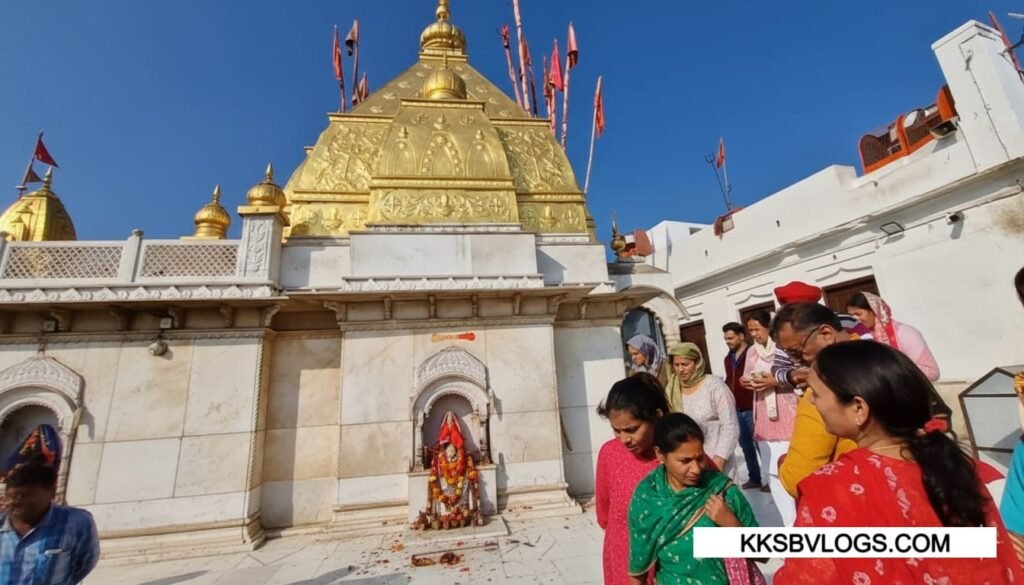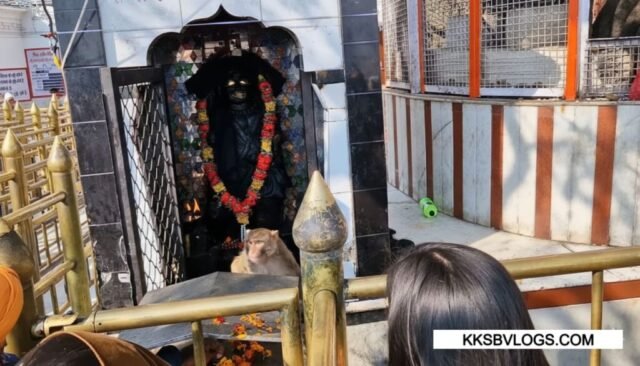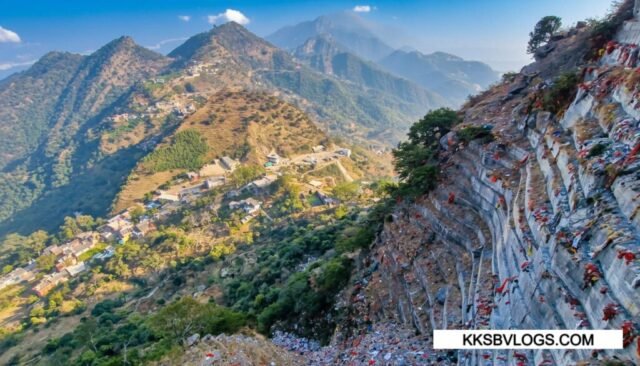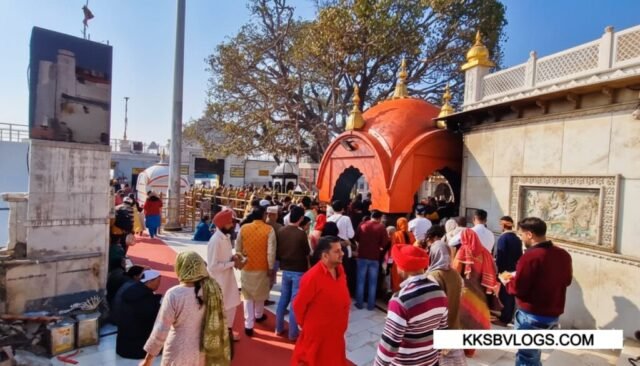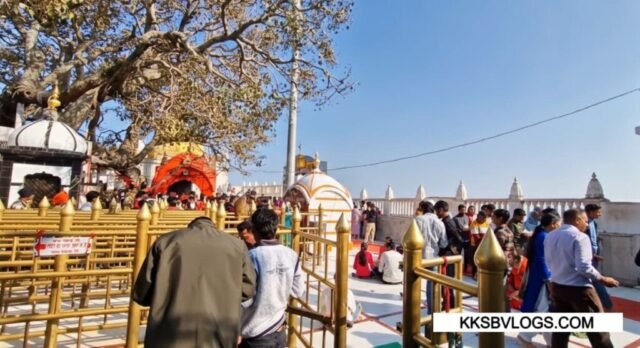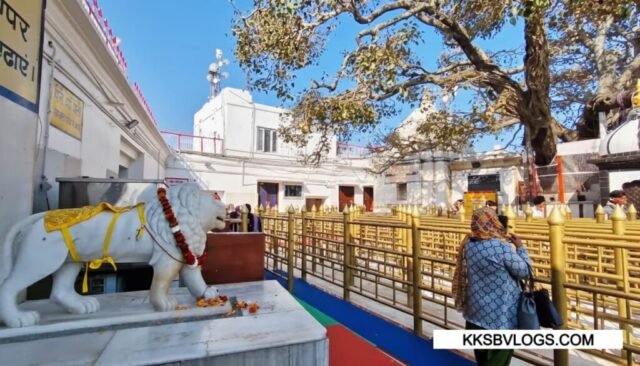1) Introduction
Bilaspur district, Himachal Pradesh is home to a spiritual jewel – Mata Naina Devi Temple – where the Himalayan serenity and the divinity of an ancient Shakti Peeth can be felt together. Located at an altitude of around 1,177 m above sea level, this temple stands on a scenic hilltop overlooking the Gobind Sagar Lake.
Situated around 120 km from Chandigarh and only 20 km from Bilaspur town, this sacred destination is one of the top pilgrimage circuits and tourist places in Himachal Pradesh.
While climbing the hilltop, you’ll be welcomed by the earthy fragrance of pine forests, the echoing temple bells, and the refreshing mountain breeze – creating a divine calmness right from the beginning of the journey. From the temple courtyard, devotees can enjoy a 360° panoramic view of the Gobind Sagar reservoir and the Shivalik hills – a paradise for photography lovers .
Mata Naina Devi Temple is believed to be one of the 52 Shakti Peethas, the holy places where the eyes (naina) of Maa Sati are said to have fallen. Pilgrims visit here seeking family protection, spiritual clarity, and life blessings. Whether you are a solo pilgrim, a family traveler, or a nature & photography explorer, this hilltop darshan offers a perfect blend of mythology, faith, and natural beauty.
In the coming sections, you’ll explore:
✨ The temple’s history & legends
✨ The Himachali architectural beauty
✨ Major festivals like Shravan Ashtami Mela & Navratri
✨ The best time to visit and a detailed travel guide to plan your journey smartly.
2) History & Legends of Mata Naina Devi Temple
2.1 Shakti Peeth & Sati’s Eyes (Naina)
According to Hindu mythology, when Mata Sati self-immolated in the sacrificial fire after being insulted by her father, King Daksha, Lord Shiva wandered the universe in grief carrying her body. To maintain cosmic balance, Lord Vishnu cut Sati’s body into pieces with his Sudarshan Chakra.
It is believed that Mata Sati’s eyes (naina) fell here, giving the site its sacred name – Mata Naina Devi Temple. This makes it one of the most important Shakti Peeths in India, holding deep spiritual significance.
2.2 Raja Bir Chand & the Divine Dream
Local folklore narrates that in the 8th century, King Bir Chand heard of a miraculous incident where a white cow poured milk daily on a particular stone. Later, a Gujjar boy dreamt of the Goddess revealing that this stone was her divine manifestation (pindi).
Understanding the spiritual message, King Bir Chand built a grand temple at the site, which today continues to be a spiritual lighthouse for devotees from Punjab, Haryana, and Himachal Pradesh.
2.3 Living Legends & Pilgrim Faith
Even today, locals of Naina Devi and surrounding regions strongly believe that Mata blesses her devotees by fulfilling their wishes. During Navratri, thousands of pilgrims gather here to seek family prosperity, spiritual blessings, and travel safety.
Every year, the Shravan Ashtami fair strengthens this faith, when devotees offer deep (lamps) and prasad at the Goddess’s feet, filling the entire temple with devotion and divine energy.
3) Architecture & Spiritual Significance
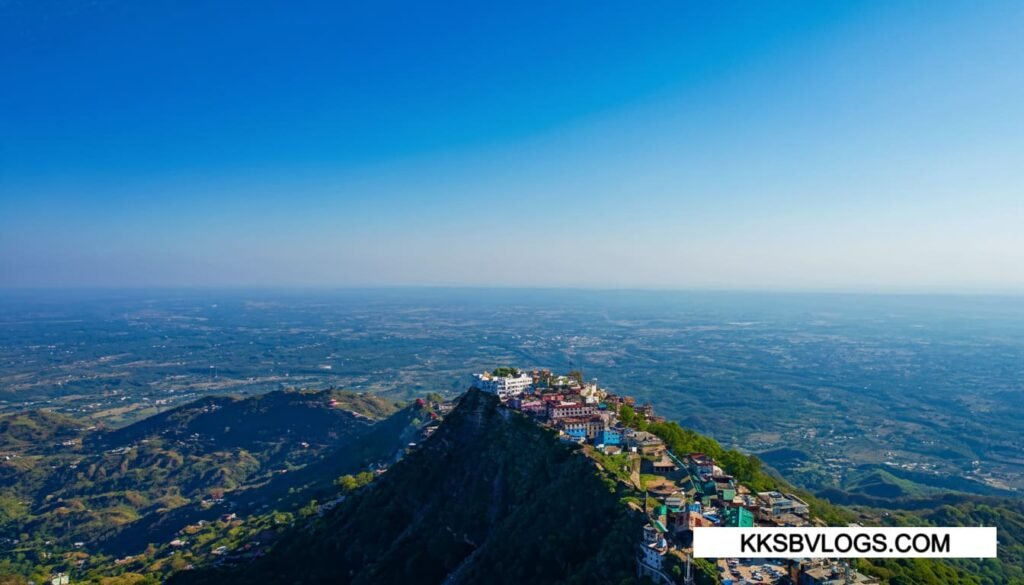
3.1 Temple Architecture – Hilltop Himalayan Charm
The architecture of Mata Naina Devi Temple is simple yet spiritually powerful. Built on a triangular hilltop, it offers breathtaking aerial views of the Gobind Sagar Lake.
The temple features a main sanctum with an open courtyard where devotees gather for aarti and bhajans. Intricate stonework, beautifully carved wooden pillars, and the red-golden color scheme reflect a unique fusion of Himachali design and ancient Shakti temple style.
Thanks to its modern ropeway service , Naina Devi has also become a popular ropeway travel destination.
3.2 Garbhagriha & Deities
Inside the sanctum sanctorum (Garbhagriha) rests the pindi form of Maa Naina Devi, accompanied by shrines of Goddess Kali and Lord Ganesha. During the morning mangal aarti, the sound of conch shells and temple bells echoes across the hilltop, creating a powerful spiritual ambiance.
Visitors arriving via the ropeway often feel the divine energy right from the temple entrance itself.
3.3 Spiritual Power & Healing Energy
Devotees believe that prayers made here for family safety, emotional balance, career success, and good health are blessed quickly by the Goddess.
The fresh mountain air combined with the temple’s spiritual vibrations acts as a natural healing therapy. Special occasions like Navratri, Shravan Ashtami, and sacred havans intensify this divine aura, leaving every pilgrim with an unforgettable spiritual experience.
4) Things to See at Mata Naina Devi Temple
Mata Naina Devi Temple in Bilaspur, Himachal Pradesh is not just a sacred hilltop shrine but also a fusion of nature views and cultural experiences. Every visitor—pilgrim or traveler—finds something unique and memorable here.
4.1 Main Sanctum & Holy Pindi Darshan
The spiritual heart of the temple complex is the Garbhagriha (inner sanctum) where the pindi form of Maa Naina Devi is worshipped. Alongside the Goddess, there are shrines dedicated to Goddess Kali and Lord Ganesha.
During the morning mangal aarti and evening deep aarti, the sound of conch shells and temple bells fills the entire hilltop. Devotees believe that darshan of the pindi fulfills wishes related to family protection, good health, and spiritual progress.
4.2 Ropeway Ride & Hilltop Viewpoints

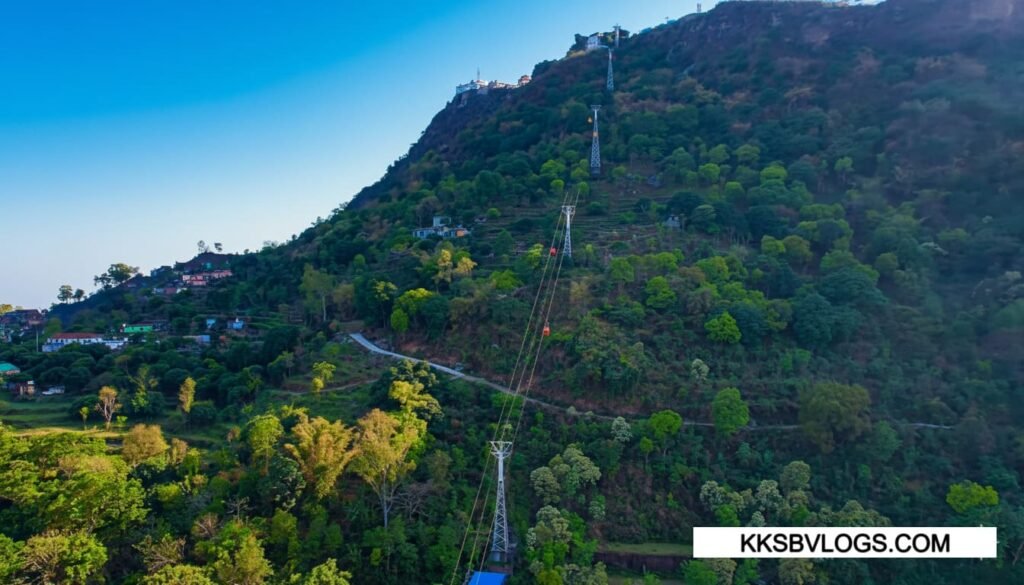
Earlier, pilgrims had to climb about 1.25 km of steep stairs. Now, the Naina Devi ropeway makes the journey easy and scenic. As the cable car ascends, travelers enjoy breathtaking 360° panoramic views of Gobind Sagar Lake and the Shivalik ranges – a dream spot for photography lovers .
At sunset, this view transforms into a golden glow, adding even more magic to the landscape.
4.3 Sacred Peepal Tree & Cave Temple
In the temple courtyard stands an ancient Peepal tree, believed to be wish-fulfilling. A long-standing tradition is to tie a sacred thread here while making a wish.
Nearby, a small sacred cave is linked with local legends of the Goddess’s appearance. Pilgrims light deepak (lamps) inside and pray for their heartfelt desires.
4.4 Gobind Sagar Lake & Nature Spots
Below the temple lies the magnificent Gobind Sagar Lake (the reservoir of Bhakra Dam) with its turquoise-blue waters. Visitors can combine their temple visit with boating or a lakeside picnic. The hillside trails and natural photo points are perfect for couples, families, and travel vloggers.

4.5 Cultural Stalls & Local Prasad Shops
From the temple entrance to the ropeway base, you’ll find local handicraft shops and prasad stalls. Popular buys include Himachali caps, wooden carvings, organic honey, and the famous Naina Devi temple prasad.
During festivals, these stalls turn into a colorful mini fair, adding a lively cultural touch to the pilgrimage.
5) Festivals & Celebrations at Mata Naina Devi Temple
The vibrant heart of Mata Naina Devi Temple shines brightest during its grand festivals, which combine deep spiritual devotion with the rich folk culture of Himachal Pradesh.
5.1 Shravan Ashtami Fair – The Grand Annual Mela
The biggest celebration at the temple is the Shravan Ashtami Mela, held during July–August (Shravan month). This fair is associated with the legend of the Goddess’s appearance and draws thousands of devotees from Punjab, Haryana, Delhi, and Himachal.
Highlights: Morning shobha yatra with palki processions, soulful bhajan-kirtan evenings, traditional Himachali Nati dance, and community bhandara (free meal service).
Spiritual Significance: Considered highly auspicious for wish-fulfillment and family well-being.
✨ Travel Tip: The crowd is very large—book hotels in advance and aim for early morning darshan for a peaceful experience.
5.2 Navratri Celebrations – Nine Nights of Divine Energy
Navratri at Mata Naina Devi Temple is a vibrant devotional festival, celebrated twice a year—March–April (Chaitra) and September–October (Sharad).
The temple is beautifully decorated with flowers, rangoli, and lights, while each day features special havans, bhajans, and deep aartis. Local families actively participate in Kanya Pujan and Navgraha Shanti rituals.
For travelers, Navratri offers a unique combination of Himachali traditions and powerful spiritual vibrations.
5.3 Jagran Nights & Special Havan
During Navratri and Shravan Ashtami, the temple hosts all-night jagrans and special Mata ki Chowkis. The entire hilltop resonates with bhajans, temple bells, and conch sounds, creating an intense spiritual atmosphere that devotees never forget.
5.4 Community Bhandara & Langar Seva
Whether it’s Navratri or Shravan fair, the tradition of bhandara and free langar is an integral part of the Mata Naina Devi experience. Managed by the temple trust and local villagers, this warm hospitality offers simple, delicious Himachali vegetarian food as an act of pure devotion and seva.
6) How to Reach Mata Naina Devi Temple
Mata Naina Devi Temple, Bilaspur, Himachal Pradesh is easily accessible from major cities like Chandigarh, Delhi, Shimla, and Punjab. Each route offers a unique travel experience.
📍 Exact Location: Hilltop near Swarghat, District Bilaspur, Himachal Pradesh
⛰️ Altitude: ~1,177 m above sea level
Distance Guide
- Bilaspur town – 50 km ( 1-2 hrs)
- Chandigarh – 105 km (3.5–4 hrs)
- Delhi – ~340 km (8–9 hrs)
- Shimla – 125 km (5 hrs)
- Anandpur Sahib (Punjab) – 25 km (30 min)
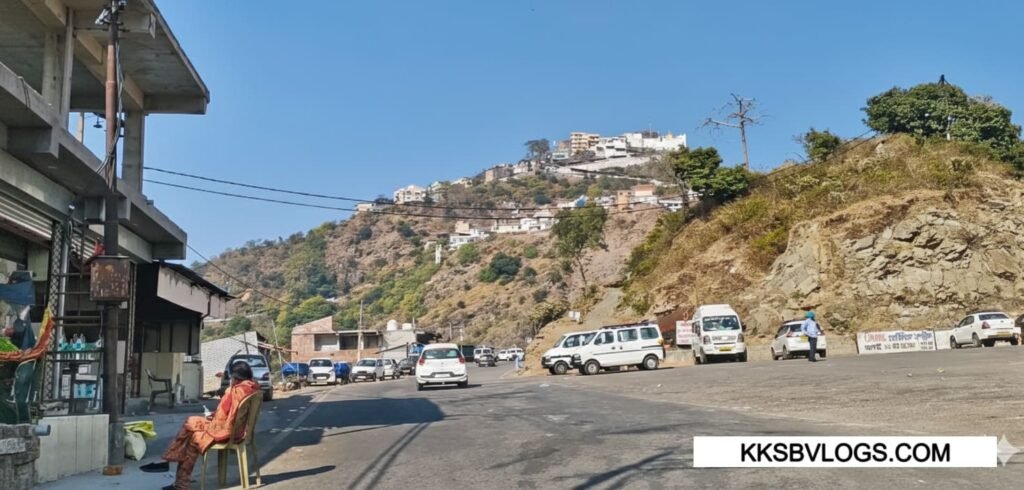
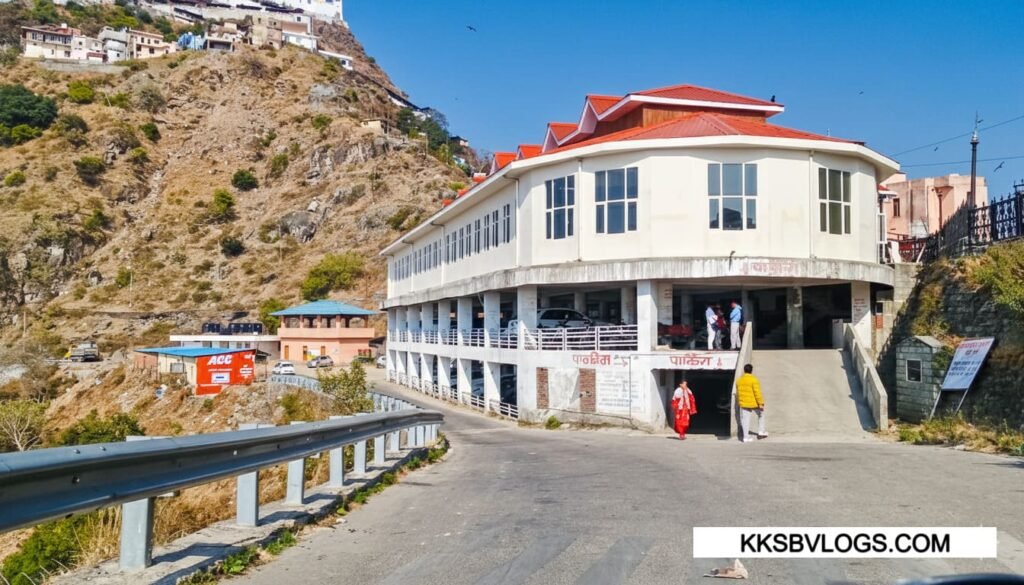
6.1 By Road – The Most Convenient Option
Road travel is the best and most popular way to reach the temple.
- From Chandigarh / Delhi: Take NH205 via Kiratpur Sahib and Anandpur Sahib. The drive is scenic and smooth.
- From Bilaspur town: Frequent HRTC and private buses, shared taxis, or personal vehicles are available.
- From Shimla / Solan: Drive via NH205 & Swarghat.
👉 Tip for Drivers: The last 3–4 km of the hill road is steep with sharp hairpin bends. Drive carefully and park at the designated hilltop parking area near the ropeway base.
6.2 By Ropeway – Scenic & Time-Saving
The Naina Devi ropeway is an experience in itself. Earlier, devotees had to climb a 1.25 km stairway, but now the modern cable car takes you to the hilltop in just 5–7 minutes.
- Ropeway Timings: 8:00 am – 6:00 pm (approx.)
- The evening sunset ride is especially stunning, offering magical views of Gobind Sagar Lake and the Shivalik ranges.
6.3 By Train – Heritage for Rail Lovers
Nearest broad-gauge railway stations:
- Anandpur Sahib station – 25 km
- Kiratpur Sahib station – 30 km
- Chandigarh station – 110 km
From these stations, taxi or HRTC buses can take you to the temple base or Swarghat.
6.4 By Air – Quickest for Long-Distance Visitors
Nearest airports:
- Chandigarh International Airport (IXC) – 120 km (~3.5 hrs drive)
- Shimla’s Jubbarhatti Airport – 170 km (~5 hrs drive)
From Chandigarh, you can directly hire a cab or bus to Bilaspur/Naina Devi.
6.5 Local Mobility & Accessibility
The temple hilltop is compact and pedestrian-friendly.
- Ropeway exit is close to the main sanctum.
- Well-paved stairs with railings are provided for seniors and children.
- For the elderly or differently abled, palki service (paid) is available.
7) Best Time to Visit Mata Naina Devi Temple
Mata Naina Devi Temple, Himachal Pradesh is open throughout the year, and every season offers a different spiritual vibe and travel flavor. Here’s a quick seasonal guide to help you plan your trip smartly:
| Season | Temp (approx) | Highlights & Travel Tips |
|---|---|---|
| March–June (Summer) | 15–28 °C | Pleasant weather, crystal-clear Gobind Sagar Lake views, easy darshan. Perfect for family trips & photography. |
| July–September (Monsoon) | 18–24 °C | Lush green hills and clouds create a mystical atmosphere. Roads may be slippery—carry a raincoat & good shoes. Great for monsoon nature lovers. |
| August (Shravan Month) | 18–22 °C | Time for the grand Shravan Ashtami Fair. Expect heavy pilgrim crowds. Pre-book hotels and reach early morning for darshan. |
| September–October (Autumn/Festivals) | 12–20 °C | Navratri celebrations light up the temple with flowers, bhajans, and a festive glow. |
| November–February (Winter) | 4–15 °C | Crisp cold air, peaceful surroundings, and low tourist rush – perfect for a quiet spiritual retreat. Carry warm jackets. |
Pro Tips for Visitors
- Early morning (7–10 am) is best for peaceful darshan and sunrise photography.
- During Shravan Ashtami Mela or Navratri, plan a day in advance and park at the ropeway base before 8 am.
- For photographers and bloggers, golden hours (sunrise & sunset) give the most beautiful light on Mata Naina Devi Temple and Gobind Sagar Lake.
8) Visitor Information – Mata Naina Devi Temple
Planning your journey with the right details will make your darshan smoother and more comfortable.
Temple Timings
- Daily: 5:00 am – 9:00 pm
- Aarti Timings: Morning 5:30 am & Evening 7:30 pm
Entry & Charges
- Entry Fee: Free
- Ropeway Ticket: ~₹150 (two-way)
Facilities
- Ample parking at the ropeway base
- Clean drinking water and washrooms
- Prasad & snack stalls
- Cloakrooms for shoes and luggage
Dress Code
- Modest, comfortable clothing is advised.
- Winters (Nov–Feb): Carry warm woolens.
Average Duration
- Around 2–3 hours for darshan, ropeway ride, and exploring viewpoints.
Photography Tips
- Allowed in courtyard and ropeway but avoid flash inside the sanctum.
Accessibility
- Palki service and hand railings on stairs help elderly or differently abled devotees.
💡 Travel Tip: During Shravan Ashtami fair or Navratri, arrive early morning and pre-book accommodation near Swarghat or Bilaspur for a stress-free visit.
9) Our Experience – Mata Naina Devi Temple
For me, Mata Naina Devi Temple, Himachal Pradesh is not just a spiritual destination, but a sacred seat of our Kulja Mata. Since childhood, I have visited many times, and each visit fills me with fresh spiritual energy and inner peace.
For my family, too, this temple is an emotional sanctuary. Sitting at the Goddess’s feet always feels like receiving her blessings directly.
Journey & Ropeway Ride
Driving early morning from Chandigarh along Gobind Sagar Lake always feels serene. As soon as we reach the ropeway base, the sight of Mata Naina Devi Temple atop the hill fills the heart with excitement.
The ropeway ride is my personal favorite. Watching the 360° panoramic views—deep blue Gobind Sagar Lake, green pine forests, and the Shivalik hills—instantly refreshes the mind. It feels like gliding through a postcard-perfect scene.
Divine Darshan
As soon as you enter, the divine echo of conch shells and bells makes the atmosphere sacred. The Garbhagriha darshan of Maa’s pindi form brings an indescribable calmness. During Navratri bhajans and aarti, the spiritual vibrations become even more powerful.
Sacred Cave Adventure
One of my most unique experiences is visiting the sacred cave (gufaa) near the temple. At first glance it feels mystical, but as you enter, there’s a strong spiritual energy. At the cave’s end lies a small Hanuman temple, giving the journey a divine closure. Devotees light lamps and pray here with deep faith.
Gobind Sagar Lake Boating
After the ropeway ride and cave darshan, I love boating in Gobind Sagar Lake. Floating on the turquoise-blue waters, with cool breezes and migratory birds around, while gazing at the temple hilltop’s reflection, feels dreamlike and soul-soothing.
Community Bhandara
The bhandara meal served by the temple trust and local villagers is another highlight. This simple Himachali vegetarian prasad, enjoyed while sitting with fellow devotees, is more than food—it’s a spiritual experience of seva and gratitude.
Every trip leaves me with the sense that Mata Naina Devi’s blessings have removed all troubles. The ropeway views, sacred cave adventure, Gobind Sagar Lake boating, Hanuman temple darshan, and bhandara meals together create an unforgettable spiritual journey.
That is why I always plan to return after a few months, because the inner peace and divine positivity found here are rare to experience elsewhere.
Nearby Attraction From Naina Devi
1. Govind Sagar Lake
A large man-made reservoir created by the Bhakra Dam. It is famous for boating, fishing, and bird-watching. The scenic surroundings make it a great spot for nature lovers and picnics.
2. Bhakra Dam
One of the highest gravity dams in India, built on the Sutlej River. It is a marvel of modern engineering and offers a spectacular view of the lake and hills around.
3. Markand (Markandeya Rishi) Temple
An ancient temple associated with Rishi Markandeya, who is believed to have meditated here. The peaceful environment makes it an important spiritual destination.
4. Vyas Cave (Vyas Gufa)
Located on the banks of the Sutlej River, this cave is believed to be the meditation place of Sage Vyas, the author of the Mahabharata. A small temple at the entrance adds to its sacred aura.
5. Kandrour Bridge
About 8 km from Bilaspur, this bridge across the Sutlej River is known for its engineering significance. It offers panoramic views of the river and valleys, making it a perfect spot for photography.
Mata Naina Devi Temple Location, Photos & Video
YouTube Video:Coming soon on – KKSB Vlogs
Instagram Updates: Stay connected with us for reels and updates– @official_kksb
Mata Naina Devi Temple Photos
Mata Naina Devi Temple Location
FAQs About Mata Naina Devi Temple
Where is Mata Naina Devi Temple and how to reach it?
The temple is on a hilltop in Bilaspur district, Himachal Pradesh, about 20 km from Bilaspur town and 120 km from Chandigarh. You can reach by road via NH205, take a 5–7 minute ropeway, or come by train to Anandpur Sahib (20 km) or Kiratpur Sahib (30 km). The nearest airports are Chandigarh and Shimla.
Why is Mata Naina Devi Temple famous?
It is one of the 52 Shakti Peethas where Mata Sati’s eyes (naina) are believed to have fallen. Devotees visit for family blessings, health, and wish fulfillment. The temple is also famous for its Shravan Ashtami fair and Navratri celebrations.
What are the temple timings and aarti schedules?
The temple is open 5:00 am–9:00 pm. Morning aarti is at 5:30 am and evening aarti at 7:30 pm. The best time for peaceful darshan is early morning (7–10 am).
What are the ropeway charges and timings?
The ropeway runs from about 8:00 am to 6:00 pm, costs around ₹150 (two-way), and reaches the hilltop in 5–7 minutes, offering beautiful views of Gobind Sagar Lake and the Shivalik hills.
Are food and stay options available nearby?
Yes. Hotels and guesthouses are available in Swarghat and Bilaspur, but advance booking is best during festivals. The temple trust serves free bhandara and langar, and small food stalls are around the temple.
Which is the best season to visit?
The temple is open all year. March–June has pleasant weather, July–September brings clouds and greenery, August is for the grand Shravan fair, Sept–Oct is ideal for Navratri, and Nov–Feb is cold but peaceful.
What other places can I visit nearby?
You can visit Gobind Sagar Lake for boating, Bhakra Dam for scenic views, Anandpur Sahib Gurudwara for Sikh heritage, Swarghat Hill Station for nature walks, and Kandrour Bridge for sunset photography.
Is the temple suitable for elderly or differently abled visitors?
Yes. The ropeway avoids the steep climb, stairs have railings, and a palki (palanquin) service is available. Benches, drinking water, and shaded resting spots are also provided.
What can I buy or take as prasad?
Visitors take temple prasad like sugar batashas, dry fruits, and coconuts. Stalls sell Himachali caps, wooden carvings, organic honey, incense sticks, and Goddess photos. During festivals, the area becomes a colorful fair.

